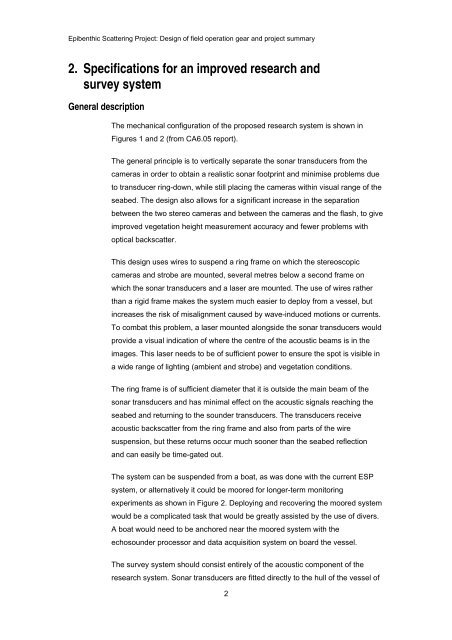Epibenthic scattering project - FTP Directory Listing
Epibenthic scattering project - FTP Directory Listing
Epibenthic scattering project - FTP Directory Listing
You also want an ePaper? Increase the reach of your titles
YUMPU automatically turns print PDFs into web optimized ePapers that Google loves.
<strong>Epibenthic</strong> Scattering Project: Design of field operation gear and <strong>project</strong> summary<br />
2. Specifications for an improved research and<br />
survey system<br />
General description<br />
The mechanical configuration of the proposed research system is shown in<br />
Figures 1 and 2 (from CA6.05 report).<br />
The general principle is to vertically separate the sonar transducers from the<br />
cameras in order to obtain a realistic sonar footprint and minimise problems due<br />
to transducer ring-down, while still placing the cameras within visual range of the<br />
seabed. The design also allows for a significant increase in the separation<br />
between the two stereo cameras and between the cameras and the flash, to give<br />
improved vegetation height measurement accuracy and fewer problems with<br />
optical backscatter.<br />
This design uses wires to suspend a ring frame on which the stereoscopic<br />
cameras and strobe are mounted, several metres below a second frame on<br />
which the sonar transducers and a laser are mounted. The use of wires rather<br />
than a rigid frame makes the system much easier to deploy from a vessel, but<br />
increases the risk of misalignment caused by wave-induced motions or currents.<br />
To combat this problem, a laser mounted alongside the sonar transducers would<br />
provide a visual indication of where the centre of the acoustic beams is in the<br />
images. This laser needs to be of sufficient power to ensure the spot is visible in<br />
a wide range of lighting (ambient and strobe) and vegetation conditions.<br />
The ring frame is of sufficient diameter that it is outside the main beam of the<br />
sonar transducers and has minimal effect on the acoustic signals reaching the<br />
seabed and returning to the sounder transducers. The transducers receive<br />
acoustic backscatter from the ring frame and also from parts of the wire<br />
suspension, but these returns occur much sooner than the seabed reflection<br />
and can easily be time-gated out.<br />
The system can be suspended from a boat, as was done with the current ESP<br />
system, or alternatively it could be moored for longer-term monitoring<br />
experiments as shown in Figure 2. Deploying and recovering the moored system<br />
would be a complicated task that would be greatly assisted by the use of divers.<br />
A boat would need to be anchored near the moored system with the<br />
echosounder processor and data acquisition system on board the vessel.<br />
The survey system should consist entirely of the acoustic component of the<br />
research system. Sonar transducers are fitted directly to the hull of the vessel of<br />
2


